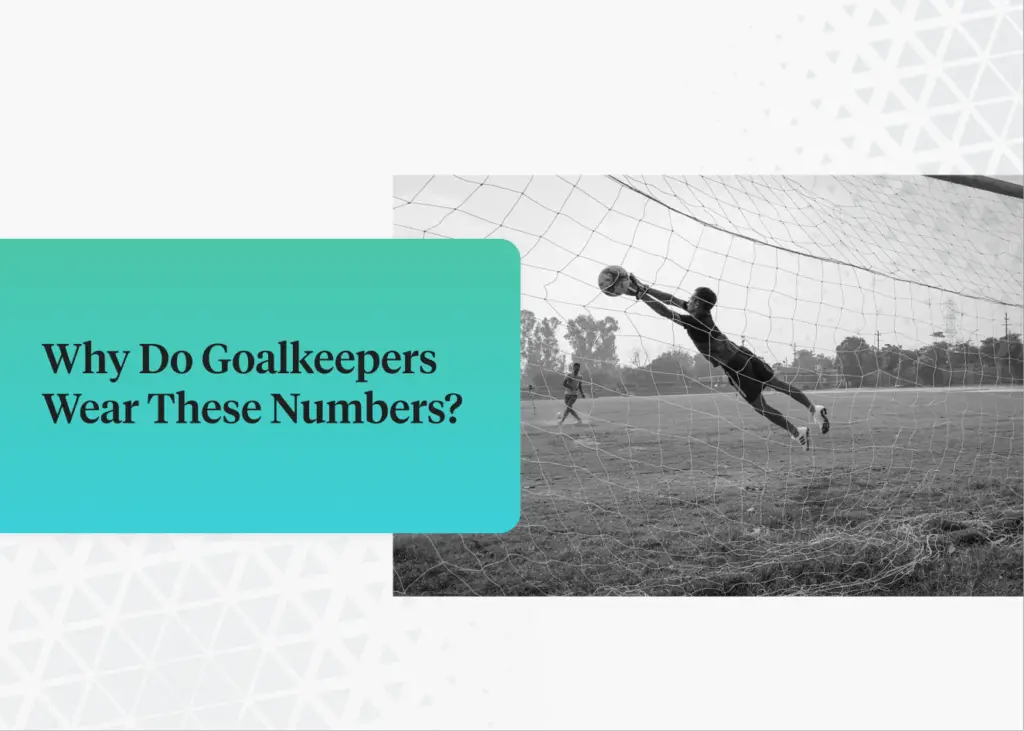Last updated on October 14th, 2022
When you are watching a football match, you may notice a certain trend where some positions may tend to wear a specific jersey number.
Somehow, goalkeepers may tend to wear either number 1, 13 or 16, but why is this so?
Here’s what you need to know:
Contents
The use of numbers in football
Before we understand why goalkeepers choose to wear certain numbers, let’s take a look at the history of numbers in football.
Numbered jerseys in football were first visible in 1911 when two Australian sides first wore numbered kits to help identify players on the pitch.
These 2 teams were Sydney Leichardt and HMS Powerful.
After this match, football leagues in New South Wales required all teams to have numbers on their jerseys. Eventually, more leagues in other countries started requiring numbered jerseys over the next few decades.
The 1950 World Cup was the first FIFA-sanctioned competition where all teams were required to have numbered jerseys. The standard teams use for numbering their players started here, with 1 going to the team’s main goalkeeper.
Why do goalkeepers wear number 1?
Football sides are traditionally arranged with the goalkeeper coming first and the rest of the side going from defence to offence. Therefore, the first choice goalkeeper will receive the number 1 jersey.
When you look at pictures of many famous goalkeepers from the past, you’ll immediately notice that most of them have the number 1 on their jerseys.
Some examples of these goalkeepers include:
When numbers were first being used in football, the goalkeeper was number 1, both full-backs were 2 and 3, and it went all the way till the striker.
The striker or centre forward is usually given the number 9 shirt.
Do goalkeepers always wear number 1?
Goalkeepers no longer need to follow the tradition of wearing the number 1 shirt, as the rules for numbering have now relaxed to allow players to choose any numbers from 1-99. As such, there may be first choice goalkeepers who choose to wear another number instead.
Over the years, teams no longer follow these strict rules for the numbers from 1-11 for the first team players. This has allowed players to choose any unique number from 1-99, where no 2 players from the same squad can have the same number.
This has resulted in some interesting number choices by goalkeepers, such as:
| Player | Number (Club) |
|---|---|
| Guillermo Ochoa | 6 (CF America) 8 (Standard Liege) |
| Rui Patricio | 11 (Wolves) |
| John Ruddy | 21 (Wolves) |
| Gianluigi Donnarumma | 99 (AC Milan) |
Why do goalkeepers wear number 13?
The second-choice goalkeeper may wear number 13 in the traditional system where numbers 12 and above will be utilised by the reserves in the squad, and a goalkeeper may choose number 13.
Although the numbering for the reserves starts from 12, most goalkeepers may choose the number 13.
For example, both Jan Oblak and Thibaut Courtois wore the number 13 when they were the second choice goalkeepers. Courtois is now number 1 at Real Madrid, while Oblak is still wearing number 13.
Some goalkeepers may choose the number 13, as it may be deemed as an unlucky number in certain religions. In this way, they may want to have a sort of ‘reverse psychology‘ by wearing the number 13, yet they will bring good luck to their team!
Nevertheless, there are other outfield players who wear the number 13, with one of the most notable being Michael Ballack.
Why do French and African goalkeepers wear number 16?
French and African goalkeepers may wear number 16 due to regulations in their league. In Ligue 1, the number 16 is specifically reserved for goalkeepers, possibly as the 5th player when 5 substitutes are allowed in a match.
Ligue 1 has some strict rules on the numbers that goalkeepers should wear, which is why Gianluigi Donnarumma was unable to wear 99 when he moved to PSG.
They had to make another exception to allow Messi to wear number 30, which was previously only reserved for goalkeepers!
For African teams, there are no official rules on the numbering of goalkeepers, but it could follow the same as the French goalkeepers.
Can another football player beside the goalkeeper wear the number 1 shirt?
While there are no official rules that prevent an outfield player from wearing the number 1 shirt, it is generally frowned upon in most occasions due to the tradition of the goalkeeper wearing the number 1 shirt.
It is quite a rare occurrence to see an outfield player wearing the number 1 shirt in a football squad, as this number is usually reserved for the goalkeeper.
However, there are quite a few players who still wear this number, including:
Another example of this was in the 1970s when the Netherlands and Argentina gave numbers to their players in alphabetical order.
Conclusion
It is fascinating to see how players on a soccer side will feature different numbers on their jerseys.
Goalkeepers will usually wear 1 and 13, but the rules may vary according to country or league.
However, most countries are rather ‘relaxed’ on the numbers that players can now wear, which has led to goalkeepers choosing different numbers apart from number 1!
You can find out why some footballers have high numbers here.
Subscribe to Telegram and Twitter to get the latest updates!

Are you passionate about football and want to earn some side income?

